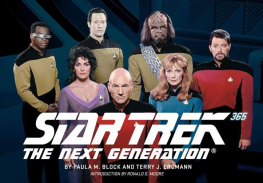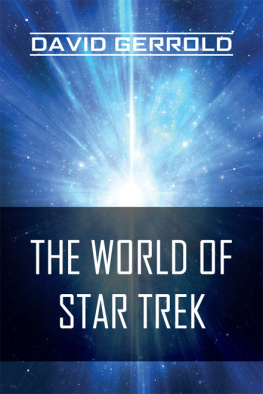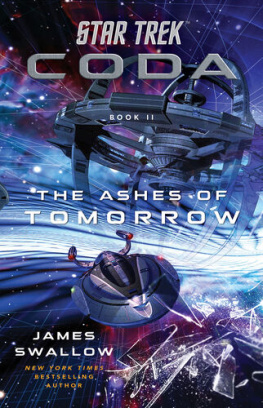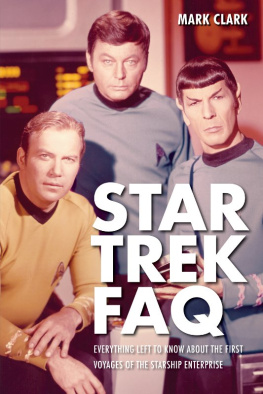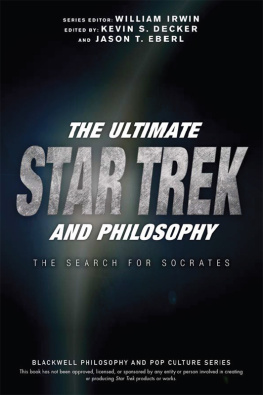For DK
Senior Editors Tori Kosara, Laura Palosuo, CefnRidout
Senior Designer Nathan Martin
Editors Kathryn Hill, Esther Ripley, SarahTomley
Designers Sam Bartlett, Marcel Carry, GaryHyde
Illustrator Nathan Martin
Pre-Production Producer Marc Staples
Senior Producer Alex Bell
Managing Editor Paula Regan
Design Manager Guy Harvey
Publisher Julie Ferris
Art Director Lisa Lanzarini
Publishing Director Simon Beecroft
DK would like to thank Beth Davies and Hannah Dolan for editorial assistance, AlexBeeden for proofreading the book, and Helen Peters for creating the index.
For CBS
Vice President of Product Development John VanCitters
Product Development Manager Marian Cordry
With special thanks to Paula Block.
First American Edition, 2016
Published in the United States by DK Publishing 345 Hudson Street New York, New York 10014
Page design Copyright 2016
Dorling Kindersley Limited, DK, a Division of Penguin Random House LLC
TM & 2016 CBS Studios Inc. 2016 Paramount Pictures Corp.STAR TREK and related marks and logos are trademarks of CBS Studios Inc. All RightsReserved.
All rights reserved. Without limiting the rights under the copyrightreserved above, no part of this publication may be reproduced, stored in orintroduced into a retrieval system, or transmitted, in any form, or by anymeans (electronic, mechanical, photocopying, recording, or otherwise) without the prior written permission of the copyright owner.
Published in Great Britain by Dorling Kindersley Limited.
A catalogue record for this book is available from the Library of Congress.
ISBN: 9781465450982
This digital edition published 2016 - ISBN: 9781465459770
DK books are available at special discounts when purchased in bulk forsales promotions, premiums, fund-raising, or educational use. For details,contact: DK Publishing Special Markets, 345 Hudson Street, New York, NewYork, 10014 SpecialSales@dk.com.
A WORLD OF IDEAS:
SEE ALL THERE IS TO KNOW
www.dk.com
INTRODUCTION
When the casual television viewer thinks of StarTrek, it might bring to mind the much-loved, pointy-eared alien with thestoic demeanor known as Spock. Or a well-known phrasemany people have utteredBeam me up, Scotty, without really knowing what it means or the factthat the phrase has never actually been used on screen, either in the movies or TVseries. Like Superman, Mickey Mouse, or a more modern hero, Harry Potter, Star Trek is known and loved around the world, and evenpeople who have never seen it on screen have some basic familiarity with its setting andcharacters.
The Star Trek movies and TV series span over 50years, and have built a vast fictional realm unlike any other. The filming of theinitial pilot episode took place in 1964, and although that episode never aired in itsoriginal form during the series first run, it inspired over 700 hours of TVepisodes and movies, adding to a library that continues to expand today. During thattime, the writers of Star Trek have created a fullydeveloped universe filled with alien species, novel languages, and a rich history withseveral timelines.
To some, the complexities of this universe are intimately familiar. The true fans knowthe series and movies in minute detail, having examined the motivations andrepercussions of the characters actions across their many screen appearances.Others may find it daunting, and may be wondering how to even begin to get a taste ofStar Treks rich storytelling. The Star Trek Book offers an easy but comprehensive way ofentering this dense and fascinating universe.
"It isnt all overeverything has not been invented; thehuman adventure is just beginning."
Gene Roddenberry
Cowboys in space
Gene Roddenberry created Star Trek in 1964,pitching it to network executives as WagonTrain to the stars, referring to a popular Western serieson US television in the late 1950s and early 60s. The initial pilot forStar Trek was called TheCage, and it introduced the core concept: in the 23rd century, a crewonboard a spaceship known as the StarshipEnterprise were exploring space. NBC network executives liked theoverall concept but asked for many changesparticularly in thecastingand made an unusual request for a second pilot.
That second pilot, called Where No Man Has Gone Before, soldNBC on the series, but neither pilot would serve as the publicsintroduction to Star Trek. A further episode,called The Man Trap, would do that. This premiered at 8:30 pm onThursday, September 8, 1966, two years after the original pilot had been filmed.The show had won a timeslot, but it fell to second place the following week andthroughout the season, though it still posted respectable ratings compared toother series launched that year.
The challenge of the science-fiction series was that its special effects, andalien costumes and makeup required a considerably higher budget than the typicalTV show. Star Trek struggled in the ratingsthrough its second season but rumors of its cancellation led to an intenseletter-writing campaign from fans. The high-production budget ultimately led tothe series cancellation at the end of a third season, butluckilyfor fansthis turned out to be just the beginning of the Star Trek story.
Strangely, Star Treks audienceactually grew after cancellation, bolstered by repeat airings in syndication.Burgeoning fan interest led to a kind of resurrection for the show in 1973, whenGene Roddenberry introduced a new cartoon series starring most of the cast inwhat became known as Star Trek: The AnimatedSeries, or simply TAS.
Star Trek: The movie
It was a few more years before the studio that owned Star Trek at the time, Paramount Pictures, decided to give thefans what they had really been asking for: A new, live-action TV series. Butwhile the studio was grappling with the financial challenges of producing theshow, George Lucass Star Wars wasreleased in cinemas. It was a massive success, and this inspired Paramount totake a new direction. Star Trek: The MotionPicture premiered in 1979, acting as a sequel film to the TVseries. More movies followed, starring the familiar crew, and they enjoyedvarious levels of financial and critical success. Then, in 1987, less than adecade after the first movie, Star Trekreturned to television with a new crew on board spaceship U.S.S. Enterprise NCC-1701-D in Star Trek: The Next Generation.
"The Starship Enterprise had nodestination. It just was out there, visiting multiple places. That may havebeen a first. To transform your idea of space is a way for me to getfrom A to B, to space is a limitless frontier toexplore."
Neil deGrasse Tyson
A new generation
Set a century later than the first series, the new series was to breaksyndication ratings records. It ran for more than twice as many years as theoriginal




